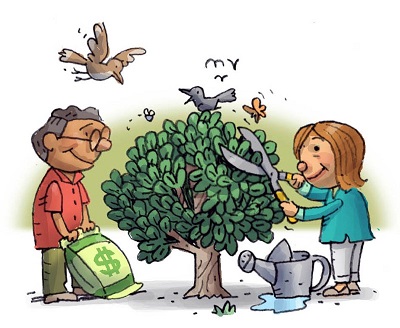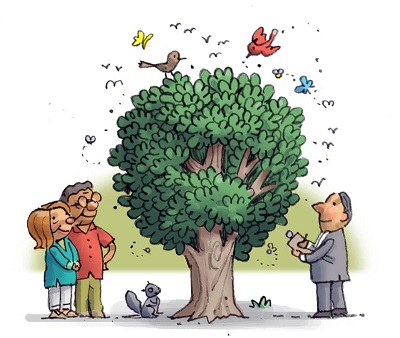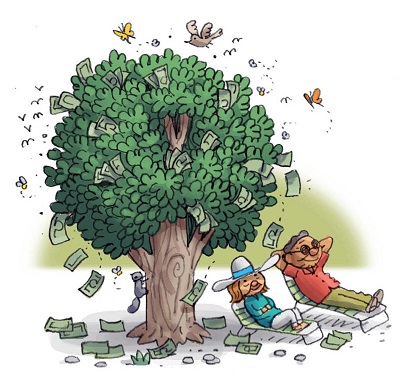
If you ask multiple financial advisors for generalized advice on money matters, they’ll likely tell you that every person’s finances are different and ever-changing based on goals and plans. If they’re advisors who specialize in socially responsible investing (SRI), they’ll also agree that no matter how much money you have, you can use your money to support sustainable business practices and local economies.
That said, Green America pinned a few of them down on general financial and SRI advice for every decade of our lives, based on where the average person is at each stage. Use it as a rough guide to maximizing the power of your investments as you go through life.
In Your 20s
People in their 20s tend to have:
- Some debt, including student loans.
- An entry-level salary in their field.
- Few expenses (may have no kids, rent instead of own a home, etc.).
- A beginner's knowledge and comfort level with investments.

Start saving early: People in their 20s may feel that the need to save for retirement is less urgent, since it’s 40-plus years away. However, Kathleen McQuiggan, senior vice president of Global Women’s Strategies at Pax World {GBN} stresses that the money you put away today will compound over time, so the earlier you start saving, the more you’ll have when you need it most.
Steve Dixon, principal and investment manager at Birchwood Financial Partners {GBN} says it’s critical for young people to start saving. “My parents, the Baby Boom generation, didn’t need to figure this stuff out like younger generations will need to. Pensions were more prevalent and Social Security was more secure. Nowadays, [no one can count on these]. It’s much more critical that young people save for retirement. The nice part is that there are lots of ways to do it.”
Save as much as you can: Elizabeth Warren, Massachusetts Senator and bankruptcy expert, coined the “50/30/20” rule of budgeting, which suggests you should keep your necessary costs to 50% of your after-tax income, spend up to 30% on “wants,” and sock 20% into savings. When you’re just starting out in the working world, 50/30/20 might be more of a goal than a reality, but make a point to save as much as you can until you can reach 20%.
Make saving routine: Steve Dixon says your financial plan in your 20s should emphasize making saving for retirement part of your routine.
“It’s like working out or exercising or eating right; if you build it into a routine, it’s so much easier than if you put it off,” he says. “Don’t wait until you have money to put away, because invariably, we never feel like we have enough money to put away.”
Get involved in your workplace retirement account: The easiest place to start saving is at work: If your employer offers a retirement savings account and will match a portion of your savings, take advantage of that—it’s free money! Make sure to save at least the amount that earns you the maximum employer match amount.
Save more if you’re a woman: McQuiggan warns young women to consider their savings and investments even more strategically than men: “Women live five to six years longer than men. Also, the wage gap exists—[white] women make 80 cents [for every dollar a man makes, and women of color make even less]. So when women retire, they have to have more money than men.”
Considering SRI:
Break up with your mega-bank: The easiest thing to do to use your money for good is to switch banks. Break up with your mega-bank, if you belong to one, and choose a community investing bank or credit union. (The federal government provides certification for some, which will be called “community development financial institutions.” Not all are certified.)
Community investing banks and credit unions are known for treating customers better and generally charging lower fees than mega-banks. Most allow the same convenience of online banking that a mega-bank would have.
Where does the socially responsible part come in? Community investing banks and credit unions have a mission to use their money to lift up low- and middle-income communities. For example, Wells Fargo lends its money to fossil-fuel projects, while many community investing banks make a point of avoiding fossil fuels, instead lending money to foster local businesses, support people trying to buy homes, and more. Community investing banks and credit unions are federally insured, which means they’re just as safe as a mega-bank or your local bank.
Get SRI into your workplace retirement account: Ask your employer if socially responsible funds are included in your workplace retirement account. If they aren’t, ask your employer to consider adding them.
In Your 30s
People in their 30s tend to have:
- Less debt.
- A higher salary than in their 20s.
- Growing expenses, from buying a home, growing a family, etc.
- Some retirement savings.

Set aside an emergency fund: The investment advice site Betterment.com recommends making sure you have an emergency fund by your early 30s. Most experts recommend setting aside at least six months’ worth of your salary in a savings account, in case of illness or job loss, for example.
Don’t cash out retirement accounts: People with even a small amount of retirement savings shouldn’t cash it out early, an article from Money Magazine warns. When you cash out a 401(k), the government takes out extra taxes, so a $5,000 balance could turn into $3,500 cash. If you leave your retirement accounts alone, you keep the money growing.
Reconsider your savings: As you age, make a point to divert as much as you can into retirement and other savings. Increase your contribution to your workplace retirement account, which you can have your employer automatically pull from your paycheck. And have your bank or credit union automatically divert money from your checking account into savings every paycheck, as well.
Consider mutual funds: If you didn’t already start in your 20s, investing some of your savings in mutual funds may also be a good option in your 30s, because at a younger age, you can be more tolerant to risk since you have time to absorb any losses. As a general rule of thumb, the higher the risk, the more potential for greater returns.
Considering SRI
SRI mutual funds: Generally, socially responsible mutual funds do as well or outperform the general market (see p. 15), making them a great option for green-minded people in their 30s who want to get started investing outside of a retirement account.
Look for socially responsible mutual funds, such as those listed in the “Mutual Funds” category at Green America’s GreenPages.org. Mutual funds offer automatic diversification, which can help minimize risk, and most types are actively managed.
A socially responsible financial advisor: Your life is likely to go through some big changes in your 30s. You may get married and/or start a family, and you may buy your first home. Consequently, your finances will go through some big changes as well. A financial advisor can help you navigate these changes. Look for a socially responsible financial advisor, who can offer general financial advice and help you invest your money in line with your values.
Community investing: Your 30s may be a good time to maximize the social aspect of your portfolio and move some of your money into community investments that go beyond banking. These investments help finance community-building projects in the US or elsewhere in the world. They may help people build houses, install renewable energy, start small businesses, or otherwise help lift up local communities.
The Calvert Foundation {GBN}, for example, offers Community Investment Notes, which put your money into a pool of community development projects across the US and around the world—from loans for women-owned small businesses in Tanzania powered by solar to loans for affordable housing in Baltimore.
“Community investing is an important part of every portfolio and can play a key role in diversification,” says Fran Teplitz, Green America’s executive co-director.
In Your 40s
People in their 40s tend to have:
- The highest wages of their careers.
- Long-term loans from big purchases.
- Established retirement savings.
- A need to continue saving for big purchases/children’s needs, like college.

Max out your retirement savings: Advisors at Bankrate.com recommend making the maximum annual contribution possible to your retirement savings in your 40s, if you aren’t already. For example, for the 2019 tax year, the maximum annual contribution to a 401(k) was $19,000.
Consider individual stock investments: If you haven’t already decided to invest in individual stock, your 40s could be a good time to do so. Buying individual stock has more risk than investing in mutual funds, but the rewards can be greater if the company does well.
Considering SRI
Screen your stock investments: Research companies before buying stock in them to ensure they’re socially and environmentally responsible. And purge any companies from your portfolio that you find are being poor corporate citizens. A socially responsible financial advisor can screen your holdings for you.
Become an active shareholder: If you hold stock, you’ll receive a shareholder proxy ballot every spring. Vote your proxy ballot in favor of social and environmental shareholder resolutions (see p. 16). (Mutual fund managers receive and vote the proxy ballots for their stock holdings, and they must disclose those votes on the fund website. If you disagree with how one of your mutual funds voted on particular ballot, call the investor relations department and let them know.)
In Your 50s
People in their 50s tend to have:
- Peak savings and investments.
- A short “time horizon” until retirement.
- A continued need to help children with college, plus assist aging parents with health and other issues.

Consider lessening your investment risk: As you start to think about retirement in the next decade or so, it may be time to shift your investments to be more conservative. Bill Holliday of AIO Financial uses the term “time horizon” to talk about how much time people can keep their money in an investment before they need it back.
"We don’t want to be forced to sell out of a volatile market when markets are down. If you have a short time horizon or don’t tolerate much risk, you want to have a good amount in fixed, stable investments,” Holliday says.
Consider your personal time horizon until retirement, and check with a financial advisor to see if lessening investment risk is right for your portfolio.
Considering SRI
Find lower-risk socially responsible investments: Just because your investments may be getting less risky doesn’t mean you have to compromise on your values. No matter what your risk tolerance and time horizon, you or a financial planner will still be able to find socially responsible alternatives that fit with your needs.
Government bonds and certificates of deposit (CDs), for example, offer fixed returns and less risk for investors. Money market funds, or pools of CDs, bonds, and certain other investments offer automatic diversification and reduced risk.
SRI At Retirement (65+)

At 65, you might be setting the date for your retirement, or be retired, and you’re starting to withdraw from your savings and investment accounts. (Be sure to read up on the requirements for starting such withdrawals, to avoid fines or penalties.)
Steve Dixon suggests reconsidering community investing, which generally has a low level of risk, when you retire.
“If I know I’m going to need that money in 18 months, if I’m being prudent, I shouldn’t be willing to take a lot of risk,” he says. “I want it in something secure.”
Community investments can deliver social impact while simultaneously being available for the near term. Many community investments allow you to choose an investment term of anywhere from one to 15 years.







